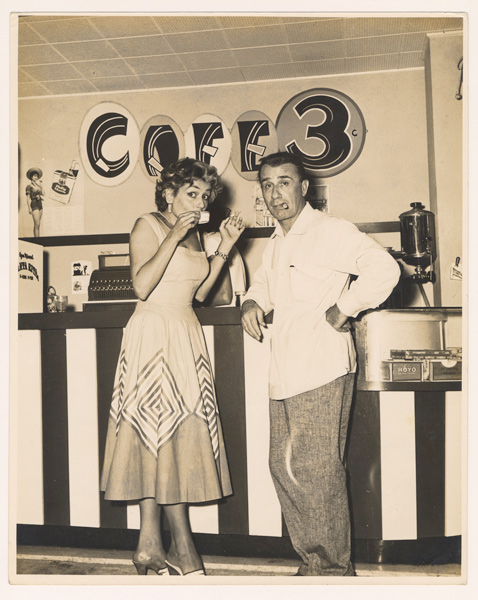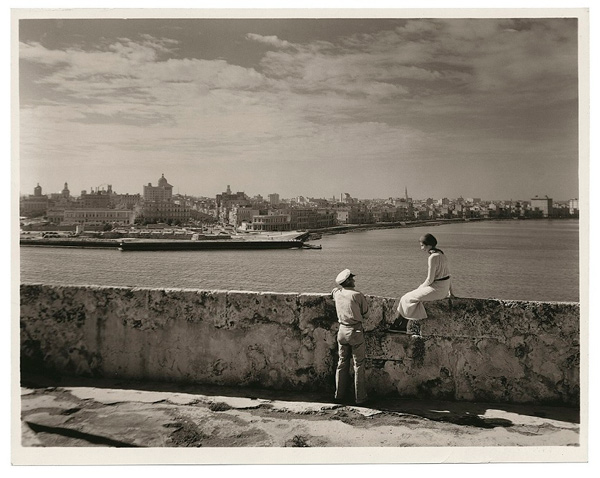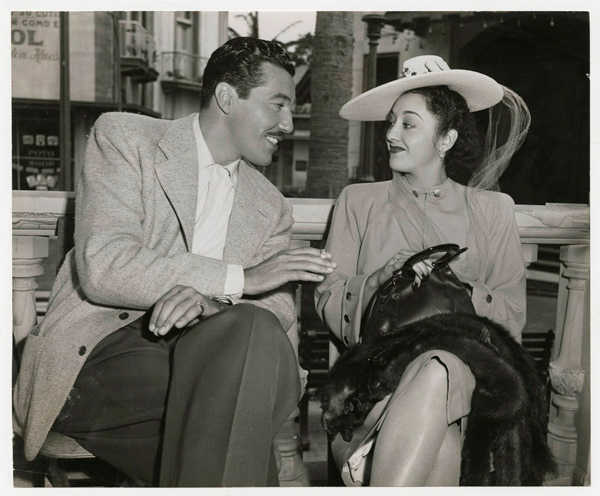Cuba Then, a Photo Book Collection
By Dawn Gable
HAVANA TIMES — Ramiro A. Fernandez certainly chose the right photo from his “rare and classic” collection to use as the cover of this 288 page picture book. The 1952 signed print of entertainers Josephine Baker (French) and Ernesto Bonino (Italian) is arguably the best photo in the book, esthetically speaking, and gives the potential reader a fair warning of what to expect inside.
What’s inside? An overabundance of scantily clad starlets, entertainment and sports stars, studio poses of wealthy little children (boy with toy horse, boy with puppy, girl on swing, boy in sailor suit), well over a dozen 19th century seated portraits of god-knows-who, and of course a short obligatory series of cars.

The book falls short on photos catching people in the act of living. While there is the occasional image of a vendor or laborer, most of these are posed shots as well, leaving the pages dry and lifeless. Quite a disappointing assemblage from “one of the largest [image collections] outside of the island nation.”
The organization of the book is an unsolved mystery. Pages flip from 19th century portraits of elite youth dressed for carnival, to Che Guevara playing chess with rag-tag soldiers in 1964, followed by a tamales vendor seemingly posing for an advertisement in 1953. Random.
Save for his short and interesting biographical introduction, the author seems to have no story to tell. No understanding, beyond the visible snap instant, of those populating his collection. To be fair, perhaps it was never his intention to paint a picture out of his photos. But the title of the book suggests otherwise.
The rare treats I found among the lot were a couple of panoramic views of Havana before the turn of the century. These were simply fascinating and made for a few fun minutes of playng “what’s there now?” with a friend.

All in all, it took me the whole of 90 minutes to peruse the book from front to back cover, including reading the poetry by Richard Blanco, the poet of Cuban decent who recited at President Obama’s second inauguration. His lines here seemed to be awkwardly forced into the overall composition.
The best I can do is recommend that you thumb through the pages while hanging out at your local book store waiting for your favorite beverage to be brewed, but then put it back on the shelf and save your money for a refill.
Cuba Then: Rare and Classic Images from the Ramiro Fernandez Collection
Introduction by Ramiro A. Fernandez
Forward and poems by Richard Blanco
The Monacelli Press (April 15, 2014)








Your insulting description of Josephine Baker is as false as it is racist. Shame on you for demeaning such a courageous and principled black woman who was a leading member of the NAACP and a recipient of the Croix de guerre from the government of France. Madame Baker faced down death threats from the Nazi’s in Occupied France & the KKK in America. The FBI kept a file on her as a suspected subversive. None of this stopped her.
In 1963, she spoke at the March on Washington at the side of Martin Luther King, Jr. Baker was the only official female speaker and while wearing her Free French uniform emblazoned with her medal of the Légion d’honneur she introduced the “Negro Women for Civil Rights.” Rosa Parks and Daisy Bates were among those she acknowledged and both gave brief speeches. After King’s assassination, his widow Coretta Scott King approached Baker to ask if she would take her husband’s place as leader of the American Civil Rights Movement. After many days of thinking it over, Baker declined, saying her children were “too young to lose their mother”.
You would do well to learn a thing or two about somebody before you open your mouth and show the world your ignorance.
http://en.wikipedia.org/wiki/Josephine_Baker
Dawn good job however noone cares about Josephine baker she was a little more than a house negress and a lolipop lover to the mafia
Even though she was a house negress to many I will never renounce mine I am Afrikan Cuban deal with it
I haven’t seen it already, so I thank you for suggesting it. I took a quick preview at my desk and liked what I saw enough to pause it and wait till I get home, pour myself a long glass of good rum and watch it on a better screen.
I love the novels of Sabo’s younger brother, Guillermo.
I don’t know why they would ban that film. It’s so full of life, joy, and of course, sex. Mucho gracias!
Although you’ve probably seen it already, a great documentary from the very first years of the Revolution, (also the first ICAIC film banned by the cultural commissars) is Sabo Cabrera Infante and Orlando Jimenez-Leal’s non-narrative film, “P.M.” a “slice-of-life” which records a Friday or Saturday night in Regla’s waterfront dives, circa 1961. It was banned because it recorded man (and woman) as s/he IS, rather than what s/he SHOULD be. Fortunately, copies of the film were saved, and we can now enjoy it. (Not sure, but some out-takes of “P.M.” seem to open “Memories of Underdevelopment.” If not, then similar documentary scenes.)
Again, still can’t find the documentary of Antonio Maria Romeu jamming with a small tipica Cuban orchestra, also circa the early 1960’s.
By the way, Dawn, Josephine Baker was born outside of St. Louis, Missouri here in the US. She was nationalized a French citizen but she never renounced her US citizenship.
I found that “Tres Lindas Cubanas” video you mentioned, it’s terrific! The music is excellent and the wallflowers are a riot. The man who does the solo dance is great too, although some of his moves look as modern as hip-hop. Great stuff! What is the title of the movie?
Thank you for the honest review, Dawn. I followed the link to Amazon and discovered that the author, Ramiro A. Fernandez, has another book titled, “I Was Cuba”, from 2007, which has excellent reviews. This new books seems to be a re-hashing of the earlier volume.
I did not know that Cesar Romero’s grandfather was Jose Marti!
How madening… I can’t seem to find the Antonio Maria Romeu documentary I referred you to…should’ve bookmarked it. Will keep trying YouTube ’til I find. In any event, another one, which is a real laugh, is a short clip from a Mexican film of the 1930’s, showing Antonio Maria Romeu playing “Tres Lindas Cubanas” at a party; the dancing is hilarious. Even more hilarious are some of the antics of the “wallflowers!” I dare anyone not to laugh at this!
Thanks for your review, Dawn! Might be able to look at a copy here, since several independent bookstores still remain. In most places, unfortunately, they have been shuttered, victims of Amazon.com. I went to the latter, but it doesn’t offer any “free samples.” For more accessable alternatives, try the various postings on YouTube and Vimeo, especially the travelog “Cuba in the 1930’s,” which is a real hoot, and also one from the 1950’s, too, which shows Habana Vieja, Centro and the Vedado in much better shape, with new Art Deco buildings; now, as you know, many are crumbling, and others have even fallen down. I’ve found al sorts of treasures on YouTube, such as a short 1961 or 1962 ICAIC documentary on Antonio Romeu, which has him leaving his apartment in Centro and going to a rehersal studio up the street, where he proceeds to direct a studio orchestra in some of his works.